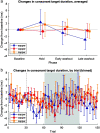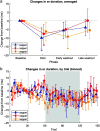Auditory Feedback Is Used for Adaptation and Compensation in Speech Timing
- PMID: 34310188
- PMCID: PMC8642089
- DOI: 10.1044/2021_JSLHR-21-00021
Auditory Feedback Is Used for Adaptation and Compensation in Speech Timing
Abstract
Purpose Real-time altered feedback has demonstrated a key role for auditory feedback in both online feedback control and in updating feedforward control for future utterances. The aim of this study was to examine adaptation in response to temporal perturbation using real-time perturbation of ongoing speech. Method Twenty native English speakers with no reported history of speech or hearing disorders participated in this study. The study consisted of four word blocks, using the phrases "a capper," "a gapper," "a sapper," and "a zapper" (due to issues with the implementation of perturbation, "gapper" was excluded from analysis). In each block, participants completed a baseline phase (30 trials of veridical feedback), a ramp phase (feedback perturbation increasing to maximum over 30 trials), a hold phase (60 trials with perturbation held at maximum), and a washout phase (30 trials, feedback abruptly returned to veridical feedback). Word-initial consonant targets (voice onset time for /k, g/ and fricative duration for /s, z/) were lengthened, and the following stressed vowel (/æ/) was shortened. Results Overall, speakers did not adapt the production of their consonants but did lengthen their vowel production in response to shortening. Vowel lengthening showed continued aftereffects during the early portion of the washout phase. Although speakers did not adapt absolute consonant durations, consonant duration was reduced as a proportion of the total syllable duration. This is consistent with previous research that suggests that speakers attend to proportional durations rather than absolute durations. Conclusion These results indicate that speakers actively monitor proportional durations and update the temporal dynamics of planning units extending beyond a single segment.
Figures









References
-
- Bates, D. , Maechler, M. , Bolker, B. , & Walker, S. (2014). Fitting linear mixed-effects models using Ime4. Journal of Statistical Software, 1(7), 1–23. https://doi.org/10.18637/jss.v067.i01
-
- Baum, S. R. , & Blumstein, S. E. (1987). Preliminary observations on the use of duration as a cue to syllable-initial fricative consonant voicing in English. The Journal of the Acoustical Society of America, 82(3), 1073–1077. https://doi.org/10.1121/1.395382 - PubMed
-
- Bjorndahl, C. (2018). A story of /v/: Voiced spirants in the obstruent-sonorant divide [Doctoral dissertation, Cornell University] .
-
- Boucher, V. J. (2002). Timing relations in speech and the identification of voice-onset times: A stable perceptual boundary for voicing categories across speaking rates. Perception & Psychophysics, 64(1), 121–130. https://doi.org/10.3758/BF03194561 - PubMed
-
- Browman, C. P. , & Goldstein, L. M. (1986). Towards an articulatory phonology. Phonology Yearbook, 3, 219–252. https://doi.org/10.1017/S0952675700000658
Publication types
MeSH terms
Grants and funding
LinkOut - more resources
Full Text Sources

